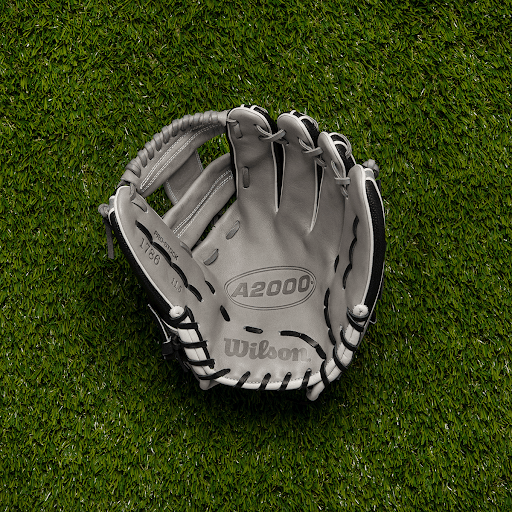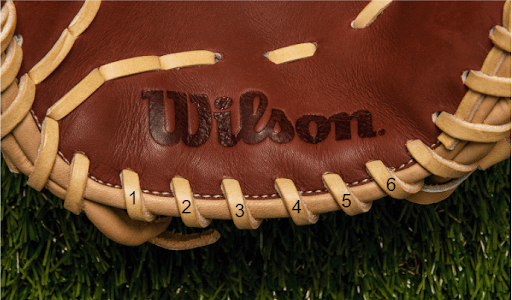When shopping for a baseball glove or softball glove, the first thing that will always catch our eyes is going to be the color of a glove. The colors of a glove are going to be important to most players, but there are a lot more criteria that can be considered when making a glove purchase. You may be surprised to learn that brands like Wilson take great efforts to make gloves that meet certain positional and player preferences. Furthermore, a lot of players, parents, and coaches will get into the mindset that the only thing that separates one glove from another glove in regard to functionality is the length; but there are many intricacies that can separate one glove from another.
Over the years, Wilson has created an impressive library of glove patterns for their A2000 gloves. Below, our Glove Experts will give you a guided tour of five of the most popular patterns that Wilson is currently creating and what makes each one unique. Let’s get started.
Wilson DP15 Gloves

This pattern was made specifically for the Boston Red Sox’s retired legend, Dustin Pedroia. About 15 years ago, Wilson tasked themselves with the challenge of building a glove that would match what Dustin Pedroia had used since he was playing youth baseball. The Glove Guru, Shigeaki Aso, visited Dustin and snapped pictures of Dustin’s hand. He also studied the way that Dustin broke in and used his glove to ensure that Wilson’s creation would match Dustin’s glove from his youth.
The result of Wilson’s hard work is an 11.5-inch glove built with an H-Web. More specifically, the thumb and pinky stalls of the glove will be designed with the propensity to be flared out (as opposed to curved in). And the lacing on the pinky and thumb of the glove will be extra long as that is a feature that Dustin loved for his glove. You can see the long lace coming off the thumb of a DP15 model below…

Dustin Pedroia has a particularly small hand and the DP15 models will be cinched up to the tightest wrist setting and have shorter finger stalls too. This makes these gloves very popular for young players hoping to get into an A2000 glove early in their career. That being said, there are actually a lot of older players who enjoy the snug fit of this glove on their hand as it allows them to feel like they have complete control over it when fielding.
To make sure they match Dustin’s childhood model perfectly, Wilson puts a thinned-out heel pad into the glove. The heel pad of the DP15 can be seen below.

Dustin remarked, “the glove that I had [and] loved when I was growing up, it had no [heel] pad in there.” He liked this feature while playing because he could really feel the ball as it was entering the glove. Wilson adds this to all of the DP15 gloves and as an added benefit, that less-bulky heel pad allows the glove to break in a little faster than a glove with a more pronounced pad.
Overall, a DP15 will get the job done for a second baseman, shortstop or third baseman. And even better, it can work for players aged 10 years all the way up to adults.To finish, read some of the raving reviews we’ve received over the years from players and parents.
“Awesome glove” - Jack [Parent]
Pros: This pro quality glove had a great fit for a 12 year old who wants a nicer glove they can grow with. This 11.5 had a much snugger fit than the 11.25 A2000 and Rawlings 11.25 I also tried. Would definitely buy this glove again.
Cons: None really, but this glove has less padding in the palm than others. But that is by design.
“Thumbs up” - Anonymous [Player]
Pros: This particular glove is amazing with fantastic leather that will last you. It is a great infield glove and it only took me a week to be able to use it with two fingers in the pinkie pocket.This glove is particularly good with turning double plays quickly.
Cons: This glove is for a smaller hand but it was great for me and you can just adjust the wrist laces. Takes a lot to break in the glove.
Wilson 1786 Gloves

Say “hello” to the most popular A2000 baseball glove that Wilson is going to build for infielders: the 1786. Aside from color, this glove will look very similar to the DP15 in its basic build. It will be 11.5” in length and feature the H-Web that is beloved by nearly all infielders.
The biggest thing that will separate a 1786 from a DP15 is that the 1786 is built to fit more of an adult-sized hand. In addition, a glove made in the 1786 pattern will not feature a thinned out heel pad like a DP15.
Due to this glove’s structure, it is naturally going to have a shallower pocket, but Wilson does their best to get that pocket feeling as large as possible. If you look at the backing of the web, you’ll notice the white strip of welting right below the base of the web…

This welting is present to help prevent the Wilson glove crafters from having to do a palm fold-over as is shown at the web base on the glove. By welting the leather at the web base of the 1786 gloves (instead of employing the palm fold-over), the gloves are able to have the largest pocket possible. Most infielders these days want the 11.5” length and H-Web, but they also want there to be a deeper pocket on the glove (the deeper pocket instills confidence that any ground ball can be handled). This welting at the web base should give the glove the feel of having a deep pocket and give players that extra tick of confidence they desire to have while out in the field.
Overall, this 1786 will be optimal for middle infielders at second base and shortstop. However, if there is a third baseman out there that likes a little bit of a shorter glove, then this 1786 could be considered for use at 3B too! Here’s what some players are saying about Wilson’s 1786 design.
“Excellent quality” - Geoff [Player]
Pros: First time I put it on it had a great feel and form. It's high quality leather and precise stitching will keep it lasting a lifetime.
Cons: It's really stiff when you first get it which takes a little longer to break in but as expected because of the high quality leather. I'm a freshman in high-school and the inside is slightly big for my hand but obviously everybody's hand is different.
“Great glove!” - Ryan [Parent]
Pros: Good glove, easy to break in, and has a good pop when the ball is caught. Also recommended for a middle infielder.
Cons: Do not force to break in or squeeze or it will make a bubble in the middle of the glove and can mess up the leather in the middle.
Wilson 1787 Gloves

You’re probably noticing by now that Wilson's H-Webs are in demand among baseball infielders. This 1787 model will display that H-Web as well. However, when compared to the DP15 and 1786, this model is going to feature a little extra length as it will register at 11.75 inches.
That extra length will make it a great choice for shortstops that want a little extra glove to cover the area to their left and right. However, the natural position for this glove is going to be at 3rd base. Since third basemen rarely have to bother with the quick exchanges and glove flips that are demanded from shortstops and second baseman, they can nearly always get away with having some extra glove length.
This 1787 will have the palm fold-over that technically makes the pocket of the glove shallow, but many players will go ahead and adjust the way they wear the glove to give it the feel of having a deeper pocket. They will do this by wearing both their pinky and ring finger within the pinky loop of the glove. Wearing the glove in that manner will force the bottom of the player’s palm to be worn on the outside of the hand slot as is shown below.

Not only does wearing the 1787 this way give the glove the feel of having a deeper pocket, but it also extends the reach that you’ll have with the glove. Check out our favorite review we’ve ever received on this design.
“1786's Bigger, Younger Brother” - Casey [Player]
Pros: Very attractive. Forms well to the hand. Accommodates 2 to the pinky. Very durable. The 1787 is 1786's bigger, younger brother, but it is not a clone of the 1786.Are the 2 gloves strikingly similar? Yes. But to me, the additional length of the 1787 seems to change the 1787's shape, as well. The 1787 seems narrower than the 1786 and, accordingly, seems to require more focus on forming and maintaining the width of the glove's pocket. The 1787's pocket, with the additional length, also strikes me as a bit deeper than the 1786's. If you want, as I did, merely a longer 1786, the 1787 very well, but not flawlessly, satisfies. Nonetheless, I recommend both the 1787 and the 1786 as terrific middle infield gloves.
Cons: If quick break-in is important to you, the 1787 takes a bit longer than the 1786 to break in. Neither, however, requires an inordinate amount of time to break in (and I break in a glove simply by wrapping the glove with an 11" softball in the pocket, tossing a baseball into the pocket, opening and closing the break points repeatedly, and playing catch.)
Wilson B2 Gloves

The B2, once coined the “B2 Bomber” by retired pitcher Tim Dillard, is a bonafide pitcher glove. It is going to have a 12-inch length and due to that size, the pocket of the glove should be pretty deep. A deep pocket will be a great value for a pitcher because it allows the player to stick nearly all of their hand and wrist into the glove. While gripping a pitch, you want to have the wrist concealed so that the batter will have a difficult time detecting any movement that could tip them to what pitch is being thrown. And to conceal the pitch grip from the batter, the glove has a two-piece, fully-closed webbing that will be impossible for a batter to peer through…

If there is a player who strictly shows up to the field to take their place on the bump. This is one of the absolute best models to consider.
Wilson 1799 Gloves

We’ve now made it to our final model and as you might have guessed, it is an outfield glove. In regard to stock gloves (ones that are continually available for purchase on their site), Wilson's longest length offered will be 12.75-inch. This 1799 model will be one of those offerings to measure out at that length. A big thing that is going to separate this model from other Wilson gloves of the same length is how wide the palm of the glove will be. If you look closely at the heel of the glove, you’ll notice 6 lace loops within the hand slot of the glove…

This wide hand opening can provide a couple of advantages. First off, if you have a larger hand and are playing outfield, there is a pretty good shot that this one will fit your hand as the hand slot will naturally be wider. Secondly, the palm-catching surface of the glove will naturally be wider than most other gloves out there. Since the heel of the glove will be extremely wide, this should help lead to a wide width of pocket as well.
Outfielders want to snare every baseball within their reach. And this 1799 is a glove that can truly help a player do that. Simply stated, the glove takes up a ton of area. By being long and wide, a fielder can sacrifice a little glove precision when laying out for a baseball. If you can touch the baseball with this glove, there is a good shot that you’ll be able to catch it!
--
There it is! A rundown of what we believe might just be the five most popular Wilson A2000 patterns out there. We’ve covered almost every position out there. Was there anything you think we missed? We’d love to hear from you on what you think is the best or most popular Wilson glove pattern out there. Our Glove Experts can be reached via phone at 866-321-4568, email at experts@justgloves.com, or click here to live chat. We're JustGloves and we're with you from Click To Catch!




